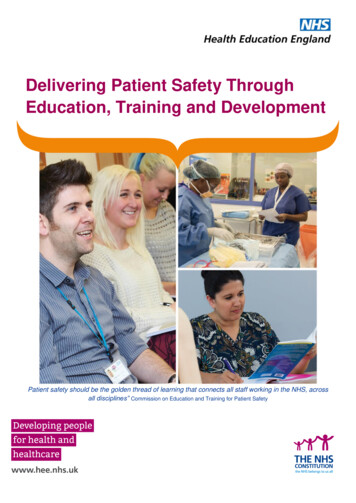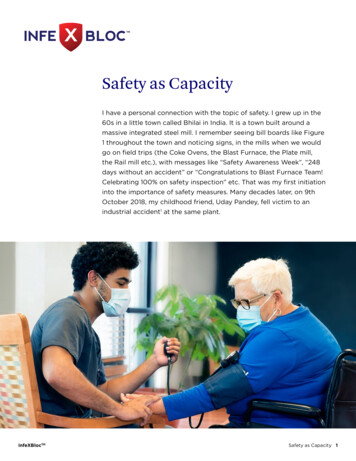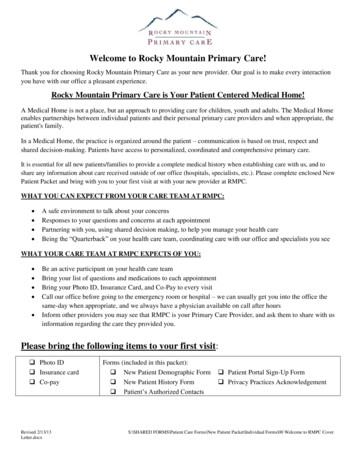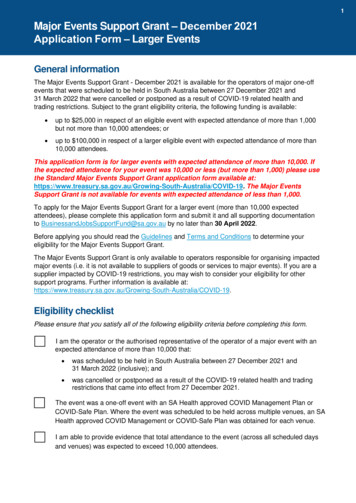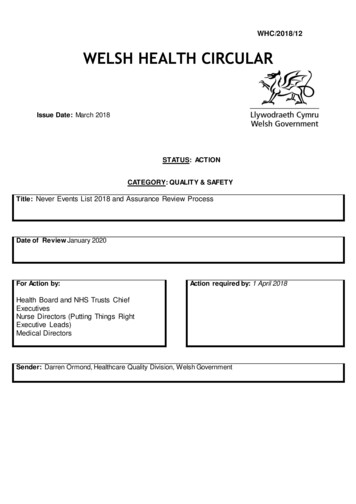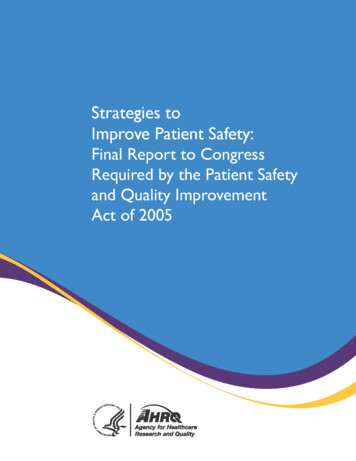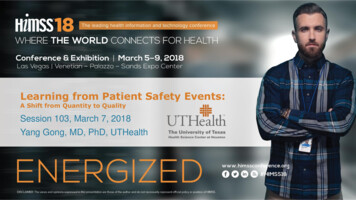
Transcription
Learning from Patient Safety Events:A Shift from Quantity to QualitySession 103, March 7, 2018Yang Gong, MD, PhD, UTHealth1
Conflict of InterestYang Gong, MD, PhDHas no real or apparent conflicts of interest to report.2
Agenda What are patient safety events Challenges of reporting patient safety events– Quantity v.s. Quality of the reports The role of clinical informatics in improving patient safety Our approaches Initial results Discussion of future steps3
Learning Objectives1. Describe the benefits of quality event reporting for patientsafety/healthcare quality improvement2. Identify the barriers of event reporting and applicable informaticsapproaches for turning reports into actionable knowledge3. Discuss how data representation and knowledge management inincident reports can facilitate quality improvement towards a betterand safer healthcare system4
Patient Safety: Pressures and IncentivesA track of patient safety study from NIH.Medical error. (Makary & Daniel, 2016)AMIA 2017 amia.org(Liang, Miao & Gong, unpublished)55
Deaths due to Patient Safety Event (PSE)AMIA 2017 amia.org66
Patient Safety Event Reporting Patient safety event (PSE) reporting– a mainstay of efforts to detect PSE and quality problems fromthe frontline practitioners– collected from a broad range of practitioners– generate a summary and feedback toward actionable knowledge shared learning7
Patient Safety Event Reporting 1999 Institute of Medicine (IOM) report– To Err is Human Patient Safety and Quality Improvement Act of 2005 (PSQIA)– Federal privilege and confidentiality protections for PSE Agency for Healthcare Research and Quality (AHRQ) Patient safety organizations (PSOs)– Analyze near misses and incidents– Identify underlying factors– Generate actionable knowledge8
Reporting Quantity and Quality Quantity– an increase in reports an improved reporting culture– a reduction in reports an indication of a safer environment Quality– underreporting– low quality and fragmented reports9
Self-Perceived Barriers Voluntary reporting– No feedback– Lengthy reporting forms competing with other priorities– Observed event seemed “trivial” A trivial tip -- a large ‘iceberg’ under water10
Goal Develop a user-centered, knowledge-based reporting and learning system– Help healthcare practitioners better report events– Connect with relevant reports– Learn how to address causes of errors– Improve the behavior at work11
Our Solution user-centered design (UCD) and knowledge-based (KB) design advancing from simply counting events into a new era ofunderstanding, trending, integrating, and resolving the events– a synchronous and collaborative platform UCD & KB features– improving user acceptance and satisfaction– promoting user engagement for shared learning quality underreporting12
Data, User, and System Data consistency– 30% labelled under ‘other’ and “miscellaneous’– 66% reports created by nurses– 75% reports created 48 hours– Quality of reports is just as significant as the number of submissions13
Data, User, and System Various terminologies in use– AHRQ Common Formats Common definitions and reporting formats Underreporting can occur– Unable to identify a proper classification or definition14
Data, User, and System Survey and interview users– Language difficulties on describing events & selecting terms– Competing priorities Retrospective think-aloud– Recall difficulties reported by inexperienced reporters– Prolonged completion time on questions15
Structured Data Entry – 13 MCQs and four of them have narrative fields as illustrated as the part BPredictive Text Entry To support reporting– Cueing list, auto-suggestionAC: Cueing Listaids in data entryof specifiedsingle-text field(B) in thestructuredquestion, orcomment field By two-group randomized testCBDCueing list that remindsof the content or contentcategories of reportable dataMain component lists multiple-choice questions in slide-in modeUnstructured Data Entry – One narrative comment field– Improved text generationEntered andtagged-in text– Improved data consistency and qualityInitial lettersof inputAuto-suggestion:matched textentry hits(# of hits 10)FEGNarrative data entry field equipped with text prediction functions16CG: Auto-suggestionSuggesting the words,phrases and sentence inthe context to describethe event details
Managing PSE Knowledge Ontology– Interoperability among home-grown systems patient safety organization (PSO) systems– Data integration organizing prevailing classifications– Decision makingPatient fallNamePatient fallAliasFall17isAPatient accidentisACauseCauseSkin tearFractureisAIncident typeisAPatientoutcome
Classifying PSE Reports Identify multiple categories -- termfrequency– Reveal details of complex cases– Reduce manual review workload– Detect systems failure18
Knowledge Support Identify similar cases based on query– Web M&M (PSNet)– Patient Safety Organization (PSO) data– Data from home-grown system Provide solution and suggestion19
Prototype20
Innovative DesignKnowledge Support (e.g., Solutions)vFeedback / PreferencesCurrent Frames Reports are stored entry by entryReporters learn nothingNo feedback for systemsProposed Frames Reports are annotated on the same feature treeProvide solutions for reportersThe system can learn from user feedback and preferences21
A New Workflow To improve data quality of PSE reporting system– Seven key modules:22
Identifying Relevant Cases23
Providing Targeted SolutionsQ6. Prior to the fall, what was the patient doing ortrying to do?Answer: b. Ambulating with assistance and/or with anassistive device or medical equipment.Specific Solutions Re-evaluate types of assistive devices used by thefacility to prevent falls. Provide training to staff on the use and maintenance ofassistive devices.24
Exploring Event ConnectionsPSE Space?Topic ModelTopic Space25
Developing a PSE Knowledge BaseSolutionsReportsTopicsA PSE Knowledge Base26
Acknowledgement Funding– Agency for Healthcare Research & Quality, 1R01HS022895– UTHealth Innovation in Cancer Prevention Research Training Program(Cancer Prevention and Research Institute of Texas grant RP#160015)– University of Texas System Grants Program #156374 Current labmembers––––Hong Kang, PhDJu Wang, PhDSicheng Zhou, BSBin Yao, MDAlumniChen Liang, MS, PhDLei Hua, PhDJames Richardson, MSZhijian Luan, MSYanyan Shen, MHARajitha Gopidi, MHACollaboratorsDan Wang, PhDMathew Koelling, MHAHsing-yi Song, MD, MSXinshuo Wu, MD, MSSwananda Pandit, MSQi Miao, BS27Jing Wang, PhD, RNNnaemeka Okafor, MD, MSHua Xu, PhDTina Hilmas RN, BSNBecky Miller MHAAmy Vogelsmeier, PhD, RNCPRIT SummerinternCindy Songting WuFrank WangAliza Ali
Questions Dr. Yang Gong gongyang@gmail.com (LinkedIn) Complete online session evaluation28
-University of Texas System Grants Program #156374 Current lab members - Hong Kang, PhD - Ju Wang, PhD - Sicheng Zhou, BS - Bin Yao, MD Alumni Chen Liang, MS, PhD Lei Hua, PhD James Richardson, MS Zhijian Luan, MS Yanyan Shen, MHA Rajitha Gopidi, MHA Dan Wang, PhD Mathew Koelling, MHA Hsing-yi Song, MD, MS Xinshuo Wu, MD, MS .
